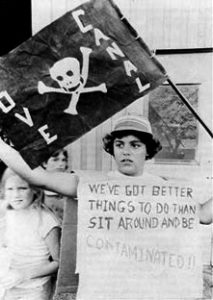What’s Love Canal Got to Do with It?
 The name “Love Canal” may invoke romantic images, and indeed, the intent was to create something beautiful. Sadly, the story is quite grizzly. The United States Environmental Protection Agency (EPA) refers to it as “one of the most appalling environmental tragedies in American history.”
The name “Love Canal” may invoke romantic images, and indeed, the intent was to create something beautiful. Sadly, the story is quite grizzly. The United States Environmental Protection Agency (EPA) refers to it as “one of the most appalling environmental tragedies in American history.”
In 1890, a man named William T. Love had a dream of creating an idealized community along Lake Ontario in New York. The first step was to generate hydroelectricity by digging a canal between the upper and lower Niagara Rivers. This energy would power the model city that would lie along the bank of the canal. Love Canal began to become a reality 1894, along with a few streets and houses. Suddenly, investors pulled out of the project, leaving only a mile of the canal completed. In 1906, Congress passed a law prohibiting water from being removed from the Niagara River. By 1910, the project was abandoned, and Love’s remaining properties were sold at auction.
It is at this point that the shattered dream morphed into a nightmare. In the 1920s, devoid of the environmental regulations that are in place today, the canal was used as a city landfill and industrial chemical dumpsite. This continued until 1947, when the canal was sold to Hooker Chemical Company. Hooker was looking for a convenient way to dispose of chemical waste, and so they drained the canal, lined it with clay, and began filling it with 55-gallon drums of toxic waste. The dumping took place over a total of 10 years.
The Niagara Falls School Board had its eye on the Love Canal dump site in 1952, wanting to fill it in and develop a school on top of it. Hooker fully disclosed the nature of the property and figured that this proposition could be an easy way to protect them from future liabilities for the buried chemicals. Hooker proposed to the school board that the property be used only as a park, but the board rejected this notion. Hooker sold Love Canal to the school board for $1, in lieu of threats of eminent domain.
Along with the school, roughly 100 homes were built on the site by the late 1950s. The construction activities caused the containment structures to be breached, leaching chemical plumes into the land. This contamination continued for 25 years, while heavy rainstorms aided the spread. Residents complained for years about strange odors and substances coming up from the ground, including a suspicious black fluid. Children returned home with chemical burns on their skin after playing outside. Corroded waste disposal drums could be seen partially unearthed from below the surface.
By 1978, the crisis at Love Canal had become a national news event. Media sources were citing abnormally large cases of birth defects, miscarriages, chromosome damage, and cancer. New York Governor Hugh Carey announced that the state would buy back affected residential properties so that the residents could evacuate. The very same day, President Jimmy Carter approved emergency financial aid for the residents, which is the first time that federal emergency funds were ever approved for something other than a natural disaster. Eventually, more than 800 families were evacuated from the area. The school was closed and demolished.
Love Canal is one of three sites that prompted the EPA to administer the Comprehensive Environmental Response, Compensation, and Liability Act of 1980 (CERCLA). CERCLA, in turn, established Superfund, which is designed to investigate and clean up sites contaminated with hazardous substances. Superfund enables the EPA to have the funds and authority to clean up contaminated sites when there is no viable responsible party. When there is a responsible party, it also forces the parties responsible for the contamination to either perform cleanups or reimburse the government for EPA-led cleanup work.
By the 1990s, Superfund had received billions of dollars through the taxation of polluting industries. By the beginning of the 21st century, cleanups at more than 750 sites had been completed. While the fallout of the dream of Love Canal was disastrous, this cautionary tale paved the way for hundreds of other Superfund sites to be cleaned up and restored to a happy ending.
Publication Details
Date
February 22, 2023



